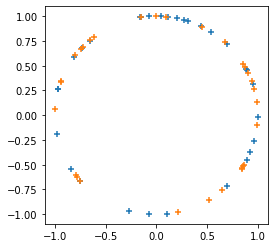এই নোটবুকের উদ্দেশ্য হল TFP 0.13.0 কে কিছু ছোট স্নিপেটের মাধ্যমে "জীবনে আসতে" সাহায্য করা - আপনি TFP এর মাধ্যমে অর্জন করতে পারেন এমন কিছু জিনিসের সামান্য ডেমো।
 TensorFlow.org এ দেখুন TensorFlow.org এ দেখুন |  Google Colab-এ চালান Google Colab-এ চালান |  GitHub-এ উৎস দেখুন GitHub-এ উৎস দেখুন |  নোটবুক ডাউনলোড করুন নোটবুক ডাউনলোড করুন |
ইনস্টল এবং আমদানি
!pip3 install -qU tensorflow==2.5.0 tensorflow_probability==0.13.0 tensorflow-datasets inference_gym
import tensorflow as tf
import tensorflow_probability as tfp
assert '0.13' in tfp.__version__, tfp.__version__
assert '2.5' in tf.__version__, tf.__version__
physical_devices = tf.config.list_physical_devices('CPU')
tf.config.set_logical_device_configuration(
physical_devices[0],
[tf.config.LogicalDeviceConfiguration(),
tf.config.LogicalDeviceConfiguration()])
tfd = tfp.distributions
tfb = tfp.bijectors
tfpk = tfp.math.psd_kernels
import matplotlib.pyplot as plt
import numpy as np
import scipy.interpolate
import IPython
import seaborn as sns
import logging
[K |████████████████████████████████| 5.4MB 8.8MB/s [K |████████████████████████████████| 3.9MB 37.1MB/s [K |████████████████████████████████| 296kB 31.6MB/s [?25h
বিতরণ [মূল গণিত]
BetaQuotient
দুটি স্বাধীন বিটা-ডিস্ট্রিবিউটেড এলোমেলো ভেরিয়েবলের অনুপাত
plt.hist(tfd.BetaQuotient(concentration1_numerator=5.,
concentration0_numerator=2.,
concentration1_denominator=3.,
concentration0_denominator=8.).sample(1_000, seed=(1, 23)),
bins='auto');
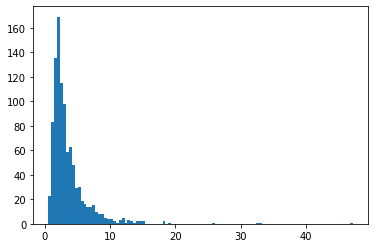
DeterminantalPointProcess
একটি প্রদত্ত সেটের উপসেটের উপর বিতরণ (এক-হট হিসাবে উপস্থাপিত)। নমুনাগুলি একটি বিকর্ষণীয় বৈশিষ্ট্য অনুসরণ করে (সম্ভাব্যতাগুলি বিন্দুগুলির নির্বাচিত উপসেটের সাথে সম্পর্কিত ভেক্টর দ্বারা বিস্তৃত আয়তনের সমানুপাতিক), যা বিভিন্ন উপসেটের নমুনা নেওয়ার দিকে ঝোঁক। [আইআইডি বার্নোলির নমুনার সাথে তুলনা করুন।]
grid_size = 16
# Generate grid_size**2 pts on the unit square.
grid = np.arange(0, 1, 1./grid_size).astype(np.float32)
import itertools
points = np.array(list(itertools.product(grid, grid)))
# Create the kernel L that parameterizes the DPP.
kernel_amplitude = 2.
kernel_lengthscale = [.1, .15, .2, .25] # Increasing length scale indicates more points are "nearby", tending toward smaller subsets.
kernel = tfpk.ExponentiatedQuadratic(kernel_amplitude, kernel_lengthscale)
kernel_matrix = kernel.matrix(points, points)
eigenvalues, eigenvectors = tf.linalg.eigh(kernel_matrix)
dpp = tfd.DeterminantalPointProcess(eigenvalues, eigenvectors)
print(dpp)
# The inner-most dimension of the result of `dpp.sample` is a multi-hot
# encoding of a subset of {1, ..., ground_set_size}.
# We will compare against a bernoulli distribution.
samps_dpp = dpp.sample(seed=(1, 2)) # 4 x grid_size**2
logits = tf.broadcast_to([[-1.], [-1.5], [-2], [-2.5]], [4, grid_size**2])
samps_bern = tfd.Bernoulli(logits=logits).sample(seed=(2, 3))
plt.figure(figsize=(12, 6))
for i, (samp, samp_bern) in enumerate(zip(samps_dpp, samps_bern)):
plt.subplot(241 + i)
plt.scatter(*points[np.where(samp)].T)
plt.title(f'DPP, length scale={kernel_lengthscale[i]}')
plt.xticks([])
plt.yticks([])
plt.gca().set_aspect(1.)
plt.subplot(241 + i + 4)
plt.scatter(*points[np.where(samp_bern)].T)
plt.title(f'bernoulli, logit={logits[i,0]}')
plt.xticks([])
plt.yticks([])
plt.gca().set_aspect(1.)
plt.tight_layout()
plt.show()
tfp.distributions.DeterminantalPointProcess("DeterminantalPointProcess", batch_shape=[4], event_shape=[256], dtype=int32)
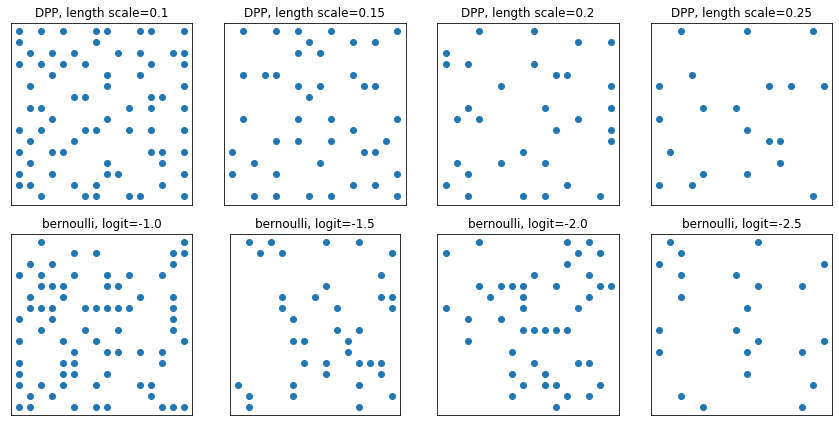
SigmoidBeta
দুটি গামা ডিস্ট্রিবিউশনের লগ-অডস। বেশি সংখ্যাসূচকভাবে স্থিতিশীল নমুনা স্থান Beta ।
plt.hist(tfd.SigmoidBeta(concentration1=.01, concentration0=2.).sample(10_000, seed=(1, 23)),
bins='auto', density=True);
plt.show()
print('Old way, fractions non-finite:')
print(np.sum(~tf.math.is_finite(
tfb.Invert(tfb.Sigmoid())(tfd.Beta(concentration1=.01, concentration0=2.)).sample(10_000, seed=(1, 23)))) / 10_000)
print(np.sum(~tf.math.is_finite(
tfb.Invert(tfb.Sigmoid())(tfd.Beta(concentration1=2., concentration0=.01)).sample(10_000, seed=(2, 34)))) / 10_000)
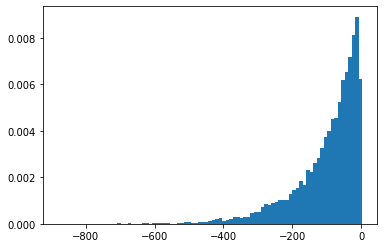
Old way, fractions non-finite: 0.4215 0.8624
জিপিএফ
JAX সমর্থন যোগ করা হয়েছে।
plt.hist(tfd.Zipf(3.).sample(1_000, seed=(12, 34)).numpy(), bins='auto', density=True, log=True);
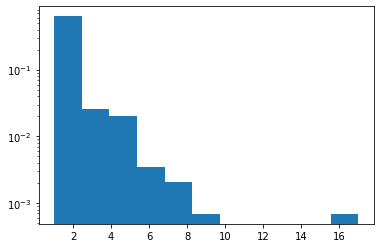
NormalInverseGaussian
নমনীয় প্যারামেট্রিক পরিবার যা ভারী লেজ, তির্যক এবং ভ্যানিলা নরমাল সমর্থন করে।
MatrixNormalLinearOperator
ম্যাট্রিক্স সাধারণ বিতরণ।
# Initialize a single 2 x 3 Matrix Normal.
mu = [[1., 2, 3], [3., 4, 5]]
col_cov = [[ 0.36, 0.12, 0.06],
[ 0.12, 0.29, -0.13],
[ 0.06, -0.13, 0.26]]
scale_column = tf.linalg.LinearOperatorLowerTriangular(tf.linalg.cholesky(col_cov))
scale_row = tf.linalg.LinearOperatorDiag([0.9, 0.8])
mvn = tfd.MatrixNormalLinearOperator(loc=mu, scale_row=scale_row, scale_column=scale_column)
mvn.sample()
WARNING:tensorflow:From /usr/local/lib/python3.7/dist-packages/tensorflow/python/ops/linalg/linear_operator_kronecker.py:224: LinearOperator.graph_parents (from tensorflow.python.ops.linalg.linear_operator) is deprecated and will be removed in a future version.
Instructions for updating:
Do not call `graph_parents`.
<tf.Tensor: shape=(2, 3), dtype=float32, numpy=
array([[1.2495145, 1.549366 , 3.2748342],
[3.7330258, 4.3413105, 4.83423 ]], dtype=float32)>
MatrixStudentTLinearOperator
ম্যাট্রিক্স টি বিতরণ।
mu = [[1., 2, 3], [3., 4, 5]]
col_cov = [[ 0.36, 0.12, 0.06],
[ 0.12, 0.29, -0.13],
[ 0.06, -0.13, 0.26]]
scale_column = tf.linalg.LinearOperatorLowerTriangular(tf.linalg.cholesky(col_cov))
scale_row = tf.linalg.LinearOperatorDiag([0.9, 0.8])
mvn = tfd.MatrixTLinearOperator(
df=2.,
loc=mu,
scale_row=scale_row,
scale_column=scale_column)
mvn.sample()
<tf.Tensor: shape=(2, 3), dtype=float32, numpy=
array([[1.6549466, 2.6708362, 2.8629923],
[2.1222284, 3.6904747, 5.08014 ]], dtype=float32)>
বিতরণ [সফ্টওয়্যার / মোড়ক]
Sharded
একাধিক প্রসেসর জুড়ে বন্টনের স্বাধীন ইভেন্ট অংশগুলি শার্ডস। দলা log_prob সঙ্গে মিলেমিশে ডিভাইস জুড়ে, হ্যান্ডলগুলি গ্রেডিয়েন্ট tfp.experimental.distribute.JointDistribution* । অনেক আরও বন্টিত ইনফিরেনস নোটবুক।
strategy = tf.distribute.MirroredStrategy()
@tf.function
def sample_and_lp(seed):
d = tfp.experimental.distribute.Sharded(tfd.Normal(0, 1))
s = d.sample(seed=seed)
return s, d.log_prob(s)
strategy.run(sample_and_lp, args=(tf.constant([12,34]),))
WARNING:tensorflow:There are non-GPU devices in `tf.distribute.Strategy`, not using nccl allreduce.
WARNING:tensorflow:Collective ops is not configured at program startup. Some performance features may not be enabled.
INFO:tensorflow:Using MirroredStrategy with devices ('/job:localhost/replica:0/task:0/device:CPU:0', '/job:localhost/replica:0/task:0/device:CPU:1')
INFO:tensorflow:Reduce to /job:localhost/replica:0/task:0/device:CPU:0 then broadcast to ('/job:localhost/replica:0/task:0/device:CPU:0', '/job:localhost/replica:0/task:0/device:CPU:1').
(PerReplica:{
0: <tf.Tensor: shape=(), dtype=float32, numpy=0.0051413667>,
1: <tf.Tensor: shape=(), dtype=float32, numpy=-0.3393052>
}, PerReplica:{
0: <tf.Tensor: shape=(), dtype=float32, numpy=-1.8954543>,
1: <tf.Tensor: shape=(), dtype=float32, numpy=-1.8954543>
})
BatchBroadcast
পরোক্ষভাবে সহ বা একটি প্রদত্ত ব্যাচ আকৃতি একটি অন্তর্নিহিত বিতরণের ব্যাচ মাত্রা সম্প্রচার করুন।
underlying = tfd.MultivariateNormalDiag(tf.zeros([7, 1, 5]), tf.ones([5]))
print('underlying:', underlying)
d = tfd.BatchBroadcast(underlying, [8, 1, 6])
print('broadcast [7, 1] *with* [8, 1, 6]:', d)
try:
tfd.BatchBroadcast(underlying, to_shape=[8, 1, 6])
except ValueError as e:
print('broadcast [7, 1] *to* [8, 1, 6] is invalid:', e)
d = tfd.BatchBroadcast(underlying, to_shape=[8, 7, 6])
print('broadcast [7, 1] *to* [8, 7, 6]:', d)
underlying: tfp.distributions.MultivariateNormalDiag("MultivariateNormalDiag", batch_shape=[7, 1], event_shape=[5], dtype=float32)
broadcast [7, 1] *with* [8, 1, 6]: tfp.distributions.BatchBroadcast("BatchBroadcastMultivariateNormalDiag", batch_shape=[8, 7, 6], event_shape=[5], dtype=float32)
broadcast [7, 1] *to* [8, 1, 6] is invalid: Argument `to_shape` ([8 1 6]) is incompatible with underlying distribution batch shape ((7, 1)).
broadcast [7, 1] *to* [8, 7, 6]: tfp.distributions.BatchBroadcast("BatchBroadcastMultivariateNormalDiag", batch_shape=[8, 7, 6], event_shape=[5], dtype=float32)
Masked
একক-প্রোগ্রাম / মাল্টিপল-ডেটা বা বিক্ষিপ্ত হিসাবে ছদ্মবেশী-ঘন ব্যবহার-ক্ষেত্রে, একটি বিতরণের জন্য যে মুখোশ log_prob অবৈধ অন্তর্নিহিত ডিস্ট্রিবিউশন করুন।
d = tfd.Masked(tfd.Normal(tf.zeros([7]), 1),
validity_mask=tf.sequence_mask([3, 4], 7))
print(d.log_prob(d.sample(seed=(1, 1))))
d = tfd.Masked(tfd.Normal(0, 1),
validity_mask=[False, True, False],
safe_sample_fn=tfd.Distribution.mode)
print(d.log_prob(d.sample(seed=(2, 2))))
tf.Tensor( [[-2.3054113 -1.8524303 -1.2220721 0. 0. 0. 0. ] [-1.118623 -1.1370811 -1.1574132 -5.884986 0. 0. 0. ]], shape=(2, 7), dtype=float32) tf.Tensor([ 0. -0.93683904 0. ], shape=(3,), dtype=float32)
বিজেক্টর
- বিজেক্টর
- অনুকরণ করতে bijectors যোগ
tf.nest.flatten(tfb.tree_flatten) এবংtf.nest.pack_sequence_as(tfb.pack_sequence_as)। - জোড়ে
tfp.experimental.bijectors.Sharded - সরান অবচিত
tfb.ScaleTrilL। ব্যবহারেরtfb.FillScaleTriLপরিবর্তে। - যোগ করে
cls.parameter_properties()Bijectors জন্য টীকা। - পরিসর প্রসারিত
tfb.Powerবিজোড় পূর্ণসংখ্যায় ক্ষমতা জন্য সব reals জন্য। - অটোডিফ ব্যবহার করে স্কেলার বাইজেক্টরের লগ-ডিগ-জ্যাকোবিয়ান অনুমান করুন, যদি অন্যথায় নির্দিষ্ট না করা হয়।
- অনুকরণ করতে bijectors যোগ
বিজেক্টর পুনর্গঠন
ex = (tf.constant(1.), dict(b=tf.constant(2.), c=tf.constant(3.)))
b = tfb.tree_flatten(ex)
print(b.forward(ex))
print(b.inverse(list(tf.constant([1., 2, 3]))))
b = tfb.pack_sequence_as(ex)
print(b.forward(list(tf.constant([1., 2, 3]))))
print(b.inverse(ex))
[<tf.Tensor: shape=(), dtype=float32, numpy=1.0>, <tf.Tensor: shape=(), dtype=float32, numpy=2.0>, <tf.Tensor: shape=(), dtype=float32, numpy=3.0>]
(<tf.Tensor: shape=(), dtype=float32, numpy=1.0>, {'b': <tf.Tensor: shape=(), dtype=float32, numpy=2.0>, 'c': <tf.Tensor: shape=(), dtype=float32, numpy=3.0>})
(<tf.Tensor: shape=(), dtype=float32, numpy=1.0>, {'b': <tf.Tensor: shape=(), dtype=float32, numpy=2.0>, 'c': <tf.Tensor: shape=(), dtype=float32, numpy=3.0>})
[<tf.Tensor: shape=(), dtype=float32, numpy=1.0>, <tf.Tensor: shape=(), dtype=float32, numpy=2.0>, <tf.Tensor: shape=(), dtype=float32, numpy=3.0>]
Sharded
লগ-নির্ধারক SPMD হ্রাস. দেখুন Sharded নিচে ডিস্ট্রিবিউশনে।
strategy = tf.distribute.MirroredStrategy()
def sample_lp_logdet(seed):
d = tfd.TransformedDistribution(tfp.experimental.distribute.Sharded(tfd.Normal(0, 1), shard_axis_name='i'),
tfp.experimental.bijectors.Sharded(tfb.Sigmoid(), shard_axis_name='i'))
s = d.sample(seed=seed)
return s, d.log_prob(s), d.bijector.inverse_log_det_jacobian(s)
strategy.run(sample_lp_logdet, (tf.constant([1, 2]),))
WARNING:tensorflow:There are non-GPU devices in `tf.distribute.Strategy`, not using nccl allreduce.
WARNING:tensorflow:Collective ops is not configured at program startup. Some performance features may not be enabled.
INFO:tensorflow:Using MirroredStrategy with devices ('/job:localhost/replica:0/task:0/device:CPU:0', '/job:localhost/replica:0/task:0/device:CPU:1')
WARNING:tensorflow:Using MirroredStrategy eagerly has significant overhead currently. We will be working on improving this in the future, but for now please wrap `call_for_each_replica` or `experimental_run` or `run` inside a tf.function to get the best performance.
INFO:tensorflow:Reduce to /job:localhost/replica:0/task:0/device:CPU:0 then broadcast to ('/job:localhost/replica:0/task:0/device:CPU:0', '/job:localhost/replica:0/task:0/device:CPU:1').
INFO:tensorflow:Reduce to /job:localhost/replica:0/task:0/device:CPU:0 then broadcast to ('/job:localhost/replica:0/task:0/device:CPU:0', '/job:localhost/replica:0/task:0/device:CPU:1').
(PerReplica:{
0: <tf.Tensor: shape=(), dtype=float32, numpy=0.87746525>,
1: <tf.Tensor: shape=(), dtype=float32, numpy=0.24580425>
}, PerReplica:{
0: <tf.Tensor: shape=(), dtype=float32, numpy=-0.48870325>,
1: <tf.Tensor: shape=(), dtype=float32, numpy=-0.48870325>
}, PerReplica:{
0: <tf.Tensor: shape=(), dtype=float32, numpy=3.9154015>,
1: <tf.Tensor: shape=(), dtype=float32, numpy=3.9154015>
})
VI
- জোড়ে
build_split_flow_surrogate_posteriorকরারtfp.experimental.viষষ্ঠ ভাড়াটে অধোদেশ গঠিত নির্মাণের স্বাভাবিক প্রবাহ থেকে। - জোড়ে
build_affine_surrogate_posteriorকরারtfp.experimental.viএকটি ইভেন্ট আকৃতি থেকে ADVI ভাড়াটে অধোদেশ নির্মাণের জন্য। - জোড়ে
build_affine_surrogate_posterior_from_base_distributionকরারtfp.experimental.viঅ্যাফিন রূপান্তরের দ্বারা প্রবর্তিত পারস্পরিক সম্পর্ক কাঠামোর সঙ্গে ADVI ভাড়াটে অধোদেশ নির্মাণের সক্রিয়।
VI/MAP/MLE
- যোগ করা হয়েছে সুবিধার পদ্ধতি
tfp.experimental.util.make_trainable(cls)ডিস্ট্রিবিউশন এবং bijectors এর trainable দৃষ্টান্ত তৈরি করুন।
d = tfp.experimental.util.make_trainable(tfd.Gamma)
print(d.trainable_variables)
print(d)
(<tf.Variable 'Gamma_trainable_variables/concentration:0' shape=() dtype=float32, numpy=1.0296053>, <tf.Variable 'Gamma_trainable_variables/log_rate:0' shape=() dtype=float32, numpy=-0.3465951>)
tfp.distributions.Gamma("Gamma", batch_shape=[], event_shape=[], dtype=float32)
এমসিএমসি
- এমসিএমসি ডায়াগনস্টিকগুলি শুধুমাত্র তালিকা নয়, রাজ্যগুলির নির্বিচারে কাঠামোকে সমর্থন করে।
-
remc_thermodynamic_integralsযোগ করাtfp.experimental.mcmc - জোড়ে
tfp.experimental.mcmc.windowed_adaptive_hmc - সীমাবদ্ধ স্থানের কাছাকাছি-শূন্য ইউনিফর্ম ডিস্ট্রিবিউশন থেকে মার্কভ চেইন শুরু করার জন্য একটি পরীক্ষামূলক API যোগ করে।
tfp.experimental.mcmc.init_near_unconstrained_zero - একটি গ্রহণযোগ্য বিন্দু পাওয়া না যাওয়া পর্যন্ত মার্কভ চেইন ইনিশিয়ালাইজেশন পুনরায় চেষ্টা করার জন্য একটি পরীক্ষামূলক ইউটিলিটি যোগ করে।
tfp.experimental.mcmc.retry_init - ন্যূনতম ব্যাঘাত সহ tfp.mcmc এ স্লট করতে পরীক্ষামূলক স্ট্রিমিং MCMC API এলোমেলো করা হচ্ছে।
- জোড়ে
ThinningKernelকরারexperimental.mcmc। - জোড়ে
experimental.mcmc.run_kernelপ্রার্থী হিসেবে চালক স্ট্রিমিং ভিত্তিক করার প্রতিস্থাপনmcmc.sample_chain
init_near_unconstrained_zero , retry_init
@tfd.JointDistributionCoroutine
def model():
Root = tfd.JointDistributionCoroutine.Root
c0 = yield Root(tfd.Gamma(2, 2, name='c0'))
c1 = yield Root(tfd.Gamma(2, 2, name='c1'))
counts = yield tfd.Sample(tfd.BetaBinomial(23, c1, c0), 10, name='counts')
jd = model.experimental_pin(counts=model.sample(seed=[20, 30]).counts)
init_dist = tfp.experimental.mcmc.init_near_unconstrained_zero(jd)
print(init_dist)
tfp.experimental.mcmc.retry_init(init_dist.sample, jd.unnormalized_log_prob)
tfp.distributions.TransformedDistribution("default_joint_bijectorrestructureJointDistributionSequential", batch_shape=StructTuple(
c0=[],
c1=[]
), event_shape=StructTuple(
c0=[],
c1=[]
), dtype=StructTuple(
c0=float32,
c1=float32
))
StructTuple(
c0=<tf.Tensor: shape=(), dtype=float32, numpy=1.7879653>,
c1=<tf.Tensor: shape=(), dtype=float32, numpy=0.34548905>
)
উইন্ডোযুক্ত অভিযোজিত HMC এবং NUTS স্যাম্পলার
fig, ax = plt.subplots(1, 2, figsize=(10, 4))
for i, n_evidence in enumerate((10, 250)):
ax[i].set_title(f'n evidence = {n_evidence}')
ax[i].set_xlim(0, 2.5); ax[i].set_ylim(0, 3.5)
@tfd.JointDistributionCoroutine
def model():
Root = tfd.JointDistributionCoroutine.Root
c0 = yield Root(tfd.Gamma(2, 2, name='c0'))
c1 = yield Root(tfd.Gamma(2, 2, name='c1'))
counts = yield tfd.Sample(tfd.BetaBinomial(23, c1, c0), n_evidence, name='counts')
s = model.sample(seed=[20, 30])
print(s)
jd = model.experimental_pin(counts=s.counts)
states, trace = tf.function(tfp.experimental.mcmc.windowed_adaptive_hmc)(
100, jd, num_leapfrog_steps=5, seed=[100, 200])
ax[i].scatter(states.c0.numpy().reshape(-1), states.c1.numpy().reshape(-1),
marker='+', alpha=.1)
ax[i].scatter(s.c0, s.c1, marker='+', color='r')
StructTuple(
c0=<tf.Tensor: shape=(), dtype=float32, numpy=0.7161876>,
c1=<tf.Tensor: shape=(), dtype=float32, numpy=1.7696666>,
counts=<tf.Tensor: shape=(10,), dtype=float32, numpy=array([ 6., 10., 23., 7., 2., 20., 14., 16., 22., 17.], dtype=float32)>
)
WARNING:tensorflow:6 out of the last 6 calls to <function windowed_adaptive_hmc at 0x7fda42bed8c0> triggered tf.function retracing. Tracing is expensive and the excessive number of tracings could be due to (1) creating @tf.function repeatedly in a loop, (2) passing tensors with different shapes, (3) passing Python objects instead of tensors. For (1), please define your @tf.function outside of the loop. For (2), @tf.function has experimental_relax_shapes=True option that relaxes argument shapes that can avoid unnecessary retracing. For (3), please refer to https://www.tensorflow.org/guide/function#controlling_retracing and https://www.tensorflow.org/api_docs/python/tf/function for more details.
StructTuple(
c0=<tf.Tensor: shape=(), dtype=float32, numpy=0.7161876>,
c1=<tf.Tensor: shape=(), dtype=float32, numpy=1.7696666>,
counts=<tf.Tensor: shape=(250,), dtype=float32, numpy=
array([ 6., 10., 23., 7., 2., 20., 14., 16., 22., 17., 22., 21., 6.,
21., 12., 22., 23., 16., 18., 21., 16., 17., 17., 16., 21., 14.,
23., 15., 10., 19., 8., 23., 23., 14., 1., 23., 16., 22., 20.,
20., 22., 15., 16., 20., 20., 21., 23., 22., 21., 15., 18., 23.,
12., 16., 19., 23., 18., 5., 22., 22., 22., 18., 12., 17., 17.,
16., 8., 22., 20., 23., 3., 12., 14., 18., 7., 19., 19., 9.,
10., 23., 14., 22., 22., 21., 13., 23., 14., 23., 10., 17., 23.,
17., 20., 16., 20., 19., 14., 0., 17., 22., 12., 2., 17., 15.,
14., 23., 19., 15., 23., 2., 21., 23., 21., 7., 21., 12., 23.,
17., 17., 4., 22., 16., 14., 19., 19., 20., 6., 16., 14., 18.,
21., 12., 21., 21., 22., 2., 19., 11., 6., 19., 1., 23., 23.,
14., 6., 23., 18., 8., 20., 23., 13., 20., 18., 23., 17., 22.,
23., 20., 18., 22., 16., 23., 9., 22., 21., 16., 20., 21., 16.,
23., 7., 13., 23., 19., 3., 13., 23., 23., 13., 19., 23., 20.,
18., 8., 19., 14., 12., 6., 8., 23., 3., 13., 21., 23., 22.,
23., 19., 22., 21., 15., 22., 21., 21., 23., 9., 19., 20., 23.,
11., 23., 14., 23., 14., 21., 21., 10., 23., 9., 13., 1., 8.,
8., 20., 21., 21., 21., 14., 16., 16., 9., 23., 22., 11., 23.,
12., 18., 1., 23., 9., 3., 21., 21., 23., 22., 18., 23., 16.,
3., 11., 16.], dtype=float32)>
)
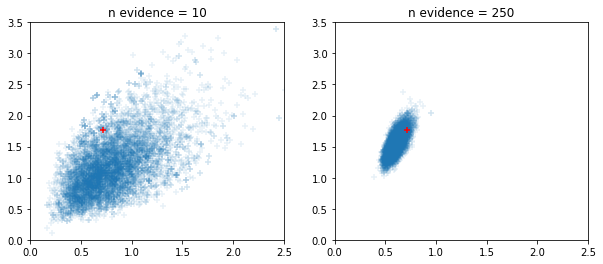
গণিত, পরিসংখ্যান
গণিত/লিনালগ
- যোগ
tfp.math.trapztrapezoidal ইন্টিগ্রেশন জন্য। - যোগ
tfp.math.log_bessel_kve। - যোগ
no_pivot_ldlকরারexperimental.linalg। - যোগ
marginal_fnআর্গুমেন্ট প্রাপ্ত করতেGaussianProcess(দেখুনno_pivot_ldl)। - যোগ করা হয়েছে
tfp.math.atan_difference(x, y) - যোগ
tfp.math.erfcx,tfp.math.logerfcএবংtfp.math.logerfcx - যোগ
tfp.math.dawsnডসন এর সমাকলন জন্য। - যোগ
tfp.math.igammaincinv,tfp.math.igammacinv। - যোগ
tfp.math.sqrt1pm1। - যোগ
LogitNormal.stddev_approxএবংLogitNormal.variance_approx - যোগ
tfp.math.owens_tওয়েন এর টি ফাংশন জন্য। - যোগ
bracket_rootএকটি রুট অনুসন্ধানের জন্য স্বয়ংক্রিয়ভাবে আরম্ভ সীমা থেকে পদ্ধতি। - স্কেলার ফাংশনের শিকড় খোঁজার জন্য চন্দ্রপতলার পদ্ধতি যোগ করুন।
- যোগ
পরিসংখ্যান
-
tfp.stats.windowed_meanদক্ষতার windowed নির্ণয় উপায়। -
tfp.stats.windowed_varianceদক্ষতার এবং সঠিকভাবে নির্ণয় বাতায়নযুক্ত ভেরিয়ানস। -
tfp.stats.cumulative_varianceদক্ষতার এবং সঠিকভাবে ক্রমসঞ্চিত ভেরিয়ানস নির্ণয় করে। -
RunningCovarianceএবং বন্ধুদের এখন, একটি উদাহরণ টেন্সর থেকে সক্রিয়া করা যাবে না শুধু স্পষ্ট আকৃতি এবং dtype থেকে। - জন্য ক্লিনার এপিআই
RunningCentralMoments,RunningMean,RunningPotentialScaleReduction।
-
Owen's T, Erfcx, Logerfc, Logerfcx, ডসন ফাংশন
# Owen's T gives the probability that X > h, 0 < Y < a * X. Let's check that
# with random sampling.
h = np.array([1., 2.]).astype(np.float32)
a = np.array([10., 11.5]).astype(np.float32)
probs = tfp.math.owens_t(h, a)
x = tfd.Normal(0., 1.).sample(int(1e5), seed=(6, 245)).numpy()
y = tfd.Normal(0., 1.).sample(int(1e5), seed=(7, 245)).numpy()
true_values = (
(x[..., np.newaxis] > h) &
(0. < y[..., np.newaxis]) &
(y[..., np.newaxis] < a * x[..., np.newaxis]))
print('Calculated values: {}'.format(
np.count_nonzero(true_values, axis=0) / 1e5))
print('Expected values: {}'.format(probs))
Calculated values: [0.07896 0.01134] Expected values: [0.07932763 0.01137507]
x = np.linspace(-3., 3., 100)
plt.plot(x, tfp.math.erfcx(x))
plt.ylabel('$erfcx(x)$')
plt.show()
plt.plot(x, tfp.math.logerfcx(x))
plt.ylabel('$logerfcx(x)$')
plt.show()
plt.plot(x, tfp.math.logerfc(x))
plt.ylabel('$logerfc(x)$')
plt.show()
plt.plot(x, tfp.math.dawsn(x))
plt.ylabel('$dawsn(x)$')
plt.show()
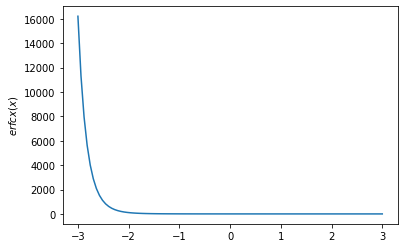
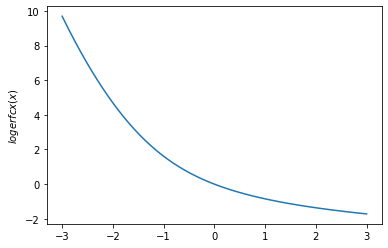
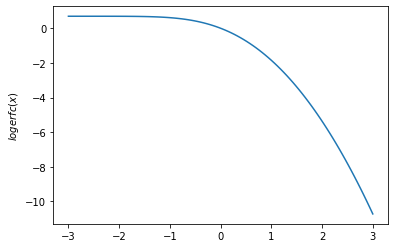
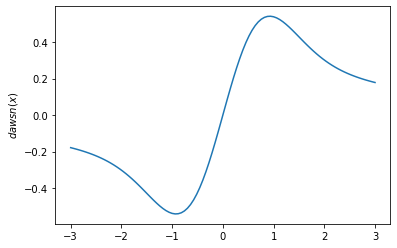
igammainv / igammacinv
# Igammainv and Igammacinv are inverses to Igamma and Igammac
x = np.linspace(1., 10., 10)
y = tf.math.igamma(0.3, x)
x_prime = tfp.math.igammainv(0.3, y)
print('x: {}'.format(x))
print('igammainv(igamma(a, x)):\n {}'.format(x_prime))
y = tf.math.igammac(0.3, x)
x_prime = tfp.math.igammacinv(0.3, y)
print('\n')
print('x: {}'.format(x))
print('igammacinv(igammac(a, x)):\n {}'.format(x_prime))
x: [ 1. 2. 3. 4. 5. 6. 7. 8. 9. 10.] igammainv(igamma(a, x)): [1. 1.9999992 3.000003 4.0000024 5.0000257 5.999887 7.0002484 7.999243 8.99872 9.994673 ] x: [ 1. 2. 3. 4. 5. 6. 7. 8. 9. 10.] igammacinv(igammac(a, x)): [1. 2. 3. 4. 5. 6. 7. 8.000001 9. 9.999999]
log-kve
x = np.linspace(0., 5., 100)
for v in [0.5, 2., 3]:
plt.plot(x, tfp.math.log_bessel_kve(v, x).numpy())
plt.title('Log(BesselKve(v, x)')
Text(0.5, 1.0, 'Log(BesselKve(v, x)')
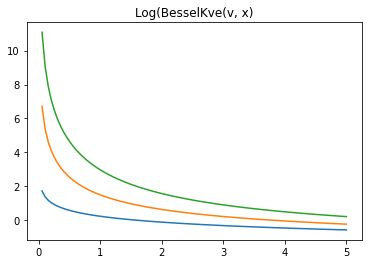
অন্যান্য
এসটিএস
- এসটিএস পূর্বাভাস ও পচানি অভ্যন্তরীণ ব্যবহার গতি বাড়ান
tf.functionমোড়ানো। - বিকল্প ফিল্টারিং গতি বাড়াতে যোগ
LinearGaussianSSMযখন শুধুমাত্র চূড়ান্ত পদক্ষেপ ফলাফল প্রয়োজন হয়। - যৌথ ডিস্ট্রিবিউশন সঙ্গে ভেরিয়েশনাল ইনফিরেনস: রাডন মডেলের উদাহরণ নোটবুক ।
- যেকোন ডিস্ট্রিবিউশনকে প্রি-কন্ডিশনিং বিজেক্টরে রূপান্তরিত করার জন্য পরীক্ষামূলক সমর্থন যোগ করুন।
- এসটিএস পূর্বাভাস ও পচানি অভ্যন্তরীণ ব্যবহার গতি বাড়ান
জোড়ে
tfp.random.sanitize_seed।জোড়ে
tfp.random.spherical_uniform।
plt.figure(figsize=(4, 4))
seed = tfp.random.sanitize_seed(123)
seed1, seed2 = tfp.random.split_seed(seed)
samps = tfp.random.spherical_uniform([30], dimension=2, seed=seed1)
plt.scatter(*samps.numpy().T, marker='+')
samps = tfp.random.spherical_uniform([30], dimension=2, seed=seed2)
plt.scatter(*samps.numpy().T, marker='+');
